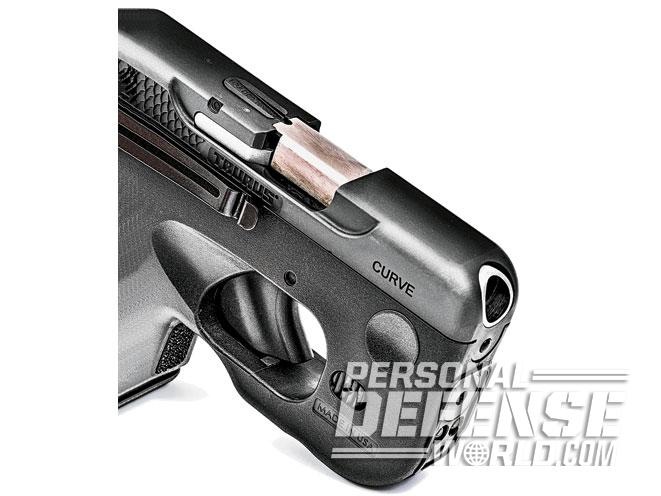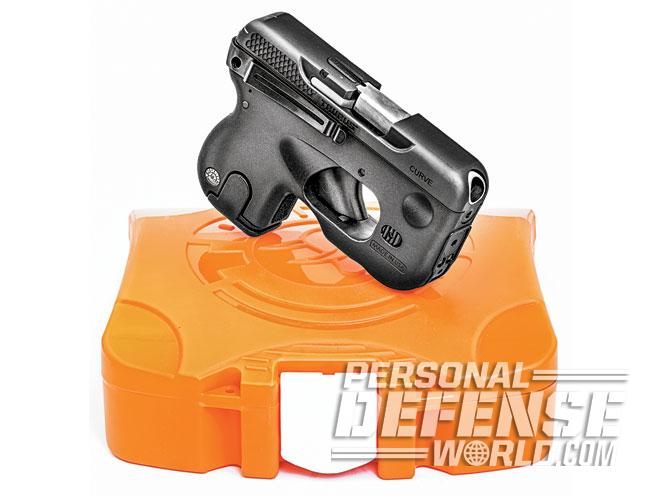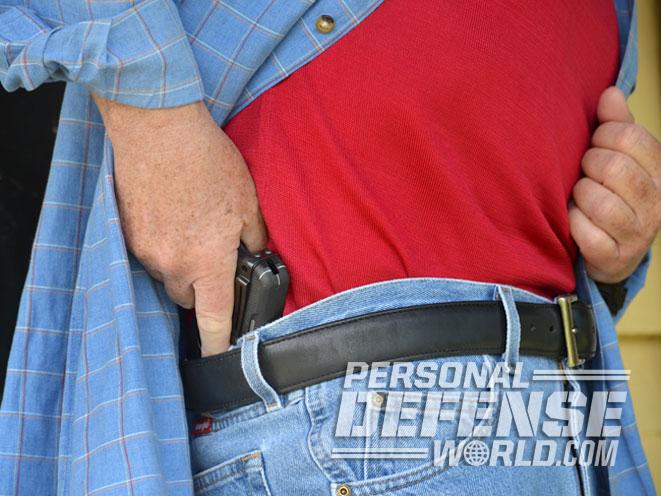As a concept, the semi-automatic pistol dates back to the 1890s. The .380 ACP cartridge was developed in 1908 by John Moses Browning, along with the first semi-auto pistol to fire it, the Colt Model 1908, which was produced up until 1940. Fundamentally, almost every .380 semi-auto pistol developed since then is tied in one way or another to the first, and nearly every one of them uses either a blowback action like a Walther PPK or a Browning-style locked-breech design.
While one might expect Taurus to have used a simple blowback action for a pistol as small and light as the Curve, the company opted for the locked breech. The immediate advantages, aside from a removable barrel and a recoil spring guide rod assembly, are reduced felt recoil and an easy-to-rack slide when loading or clearing the gun. For the Curve, the focus at Taurus was on taking a design and a cartridge, each more than a century old, and bringing them into a new century in a way that no .380 ACP semi-auto pistol had done before. That is what makes the Curve a new concept.
.380 Redux
Advertisement — Continue Reading Below

The basics of concealed-carry .380s have remained primarily in one of two configurations—those based on a polymer frame or those using steel or alloy frames, blowback actions or locked-breech designs, and an average six-round magazine capacity. Since 2003 design efforts have focused on improving fixed sights, smoothing contours to eliminate hard edges that can catch on clothing and adding laser devices to improve target acquisition.
RELATED STORY: Gun Review – Taurus Curves Ahead
Advertisement — Continue Reading Below
As for carry methods, the options have not changed in decades—a small belt holster, an inside-the-waistband (IWB) holster or a pocket or shoulder holster, each with its advantages and disadvantages. The only other viable option was a spring-steel belt clip mounted to the back of the frame, allowing the pistol to be tucked into a pocket or inside the waistband. It is with the knowledge of all that has come before that Taurus embarked upon a new concept: Take all of these improvements and integrate them into a single handgun. The result is the Taurus Curve, a pocket pistol that establishes a new standard for .380 ACP semi-automatic pistols.
New ideas, especially in firearms, are always a hard sell to the experienced handgunner, but with a growing market in concealed-carry handguns, particularly among women and men with no previous handgun experience, the Curve is almost an epiphany. It’s a small-caliber, fully-equipped and easy-to-conceal handgun that’s uniquely contoured to the body. What’s not to like?
Form-Fit Security
Advertisement — Continue Reading Below

There are established ground rules that the Curve cannot change simply because of the dynamics of how a handgun works. Taurus addresses the locked-breech, double-action-only (DAO) design by enclosing the pistol’s mechanisms in an altogether new way—with a polymer structure that contains a steel subframe and slide rails, the trigger, the hammer, the firing mechanisms, the grip, the magazine well and twin LaserLyte tactical lights (that generate about 25 lumens) and a red laser. This is all integrated into the polymer frame.
RELATED STORY: 4 Next-Gen Taurus Compacts For Concealed Carry
The lights and laser are operated from a single trigger-finger-activated switch on the right side of the gun. A slight touch and forward pressure on the switch activates both the lights and the laser; the same pressure shuts them off in an instant. Holding the button for five seconds allows the user to enable laser-only or flashlight-only modes.
Advertisement — Continue Reading Below
The Curve’s polymer frame and carbon steel slide have rounded edges, leaving nothing to catch on clothing. Even the top of the barrel is curved to blend into the slide. There is a trigger finger rest molded into the frame that allows for a simple downward movement to reach the light/laser activation switch, and a short move back to engage the large polymer trigger housing. The Curve’s DAO trigger mechanism has a long pull (as this is the only external safety mechanism) that requires nearly a full inch of travel to cock and release the internal hammer. While long, the pull is smooth. Its resistance averaged 5.8 pounds.

The six-round magazine has a curved basepad to correspond with the inner curve of the pistol’s left-side grip and frame. This produces the gun’s inner “curve,” which gently follows the contour of your body for more comfortable IWB carry (assuming you are right-handed). This also makes this little pistol unusually comfortable to hold, since the opposing outward curve of the frame rolls nicely into the hand. The pistol’s only disagreeable feature is a magazine disconnect, which prohibits the gun from firing a chambered round if the magazine is removed. You can debate the merits, or lack thereof, concerning magazine disconnects all day, and in the end it becomes a matter of personal choice, except in states where the decision is made for you by law.
RELATED STORY: Taurus M380 Revolver – A Deep-Cover Snubbie
Advertisement — Continue Reading Below
On the plus side, the Curve’s magazine design is somewhat unique in that it is its own release. There are no magazine-release buttons on the pistol. The sides of the basepad curve up into the grip frame, and pressing in on the left one allows the magazine to be removed. This is a good feature as one does not have to move the strong-hand thumb to a release button or even take the gun off target when replacing a spent magazine or performing a tactical reload.
Ever the pragmatist, I tried the Curve one-handed. And remember, this is in a life-or-death situation. Push the empty pistol with the slide locked back into your waistband for support, remove and replace the magazine, then push the rear-left edge of the slide’s ejection port (remember the front of the slide is rounded off) against a hard-edged surface. Even the heel of your shoe will do in a pinch; it doesn’t take much force to release the slide. Now you’ve successfully reloaded.
Concealing The Curve
Advertisement — Continue Reading Below

Concealed-carriers have two options for carrying the Curve, and both are IWB using the gun’s attached steel belt clip. Taurus recommends carrying the gun with a full magazine and an empty chamber, and to rack the slide to chamber the first round after drawing. Technically speaking, this is the safest means of carry, and with practice most users will be able to quickly operate the slide after drawing, but it costs you time. A loaded-chamber indicator on top of the slide rises when a round is in the chamber, so there’s a failsafe for knowing the gun’s condition at a glance.
Being DAO, the pistol is no more or less safe to carry with a chambered round than a revolver or other similar .380s without manual external safeties. Once again this is a personal choice that Taurus defers to in the instructions by stating, “Safe carry condition is a judgment call.”
RELATED STORY: Taurus’ Snub-Nosed Revolvers Deliver Threat-Stopping 24/7 Defense
Advertisement — Continue Reading Below
The other option for safe carry provided by Taurus is a removable trigger shield, a molded guard that contours to the lower frame and triggerguard and snaps into place, completely covering the trigger. The shield has a lanyard that can be laced through the wearer’s belt. When the gun is drawn, pulling upward will dislodge the trigger shield. The pistol’s belt clip keeps it secure to the wearer’s pant waist (don’t put the clip over your belt, it places too much stress on the clip and also keeps the catch at the end from making contact with your waistband). The best aspect of the trigger shield will be in what holster makers can do with the idea by molding this same contour into a curved Kydex holster that will automatically lock the handgun in place. (It is probably already being developed as you read this).
What has this concept brought to the table? In terms of weight, the Curve tips the scales at an extremely light 10.2 ounces unloaded. It has an overall length of 5.2 inches, a width that varies from 0.88 inches at the curvature of the grip to 0.874 inches at the muzzle, and it is 3.7 inches in height.
At The Range
Advertisement — Continue Reading Below

The Curve is a handgun best suited for self-defense at an average combat range of 7 yards. With a 2.5-inch barrel and seven rounds on board, you have a pistol not unlike the vast majority of polymer-framed DAO .380s on the market, only the Curve is easier to carry and conceal by design. Drawing the Curve from its IWB carry position requires sweeping the hand inside the waistband and coming up behind the grips, which, with the belt clip, places them below the top of your waistline. This provides maximum concealment save for the small metal belt clip. The draw is a beat slower than from an IWB rig, which would place the grips a little higher and easier to grasp. Where this gun departs from all other .380s is in how you sight it.

While the frame is curved the slide is not, and the Curve has a high bore axis, which makes it ideal for what Taurus calls “bore axis sighting.” Simply put, you are aligning the gun with your target along the top of the slide. To aid in this, the back of the slide has three white lines—two horizontal, one vertical—that bracket the hammer opening. Placing the top of the vertical line on target aligns the muzzle with your point of aim so long as you keep the gun level.
RELATED STORY: Gun Review – Taurus Raging Judge Magnum Revolver
Gripping the Curve is easy enough even with large hands; the backstrap and frontstrap both have deep texturing to aid in a secure grasp with the palm swell and second finger. The third finger comes up just over the leading edge at the base of the grip frame, with the little finger resting under the magazine basepad. The Curve’s grip will fit the hands of most users.
When firing the Curve, the greatest portion of the trigger’s rearward movement is taken up smoothly in the first 0.75 inches, with resistance building to the point when the internal hammer is horizontal to the opening in the back of the slide. Discharging the gun only requires a light pull beyond this point, but reset requires a full release of the trigger. One big plus is that the slide locks back after the last round is fired, but after a reload it must be manually pulled back and released. This is almost effortless. In the event of a failed primer, the trigger will not reset and the slide must be pulled back approximately 0.25 inches to reset the action.

My test ammunition consisted of one traditional full metal jacket (FMJ) round, Federal American Eagle 95 grain, and two leading personal defense loads, Hornady Critical Defense 90-grain FTX and Sig Sauer Elite Performance 90-grain jacketed hollow point (JHP). The American Eagle hardball clocked 785 fps through the ProChrono chronograph, Hornady cleared the traps at an 835 fps average and Sig Sauer flew downrange the fastest at 850 fps. That’s not bad for a 2.5-inch barrel.
RELATED STORY: The Taurus DT .357 Mag Packs a Five-Round, Fight-Stopping Punch
Fired at one-second intervals using a Weaver stance and a two-handed hold, the best groups measured 3 inches with American Eagle and Hornady, both fired at the center of a B-27 Silhouette target. All rounds hit in the 9, 10 and X rings. Moving POA to the 9 ring at 3 o’clock for the Sig Sauer ammo, the group opened up to 3.5 inches but produced the tightest pairs with two sets under 0.75 inches and one flyer. Overall, the Curve does a good job of keeping every shot in center body mass from 7 yards.
With the LaserLyte activated at dusk for one more series of tests, the Curve’s accuracy is even better. Five rounds of Hornady FTX grouped at 2.25 inches just above POA, with a best three measuring 0.26 inches! Federal’s American Eagle load put five into 2.5 inches, and Sig Sauer Elite Performance took home the day with a best group measuring 2.1 inches. Recoil with all three was comparatively light for a polymer-framed .380 ACP pistol.
The Takeaway

For someone who grew up with Colt Detective Specials and Walther PPKs for concealed carry, the Curve may be a lot to swallow. But for those already familiar with and happy to carry small polymer-framed .380s like the LCP and P-3AT, the Curve is absolutely a cutting-edge concept. Overall, I like the Curve. I’d like it better with three small white-dot sights or at least a trench-style sighting groove along the top of the slide, but it still puts rounds where you need them, especially with the integral red laser.
For more information, visit http://www.taurususa.com or call 800-327-3776.


































